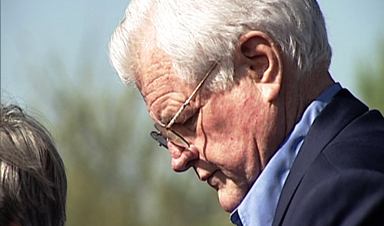Standing with 200,000 people on the National Mall in Washington, D.C. on Sunday, we remembered a friend promising that a giant immigration rally would happen--but that was 9 years ago, back when we began shooting HOW DEMOCRACY WORKS NOW. The films that are coming out now, starting with HBO2's broadcast of The Senators' Bargain Wednesday night at 8 PM, represent the journey we have all taken on the road to immigration reform.
Back in the summer of 2001, George Bush was new in office and it felt like things were just getting started. Suddenly, hush-hush plans for a big, comprehensive immigration accord with Mexico, a possible model for a complete overhaul of US immigration policy, broke onto the front page of the Sunday New York Times.
Negotiations had been underway quietly for months but the news hit Washington like a shock wave -- already there was plenty of disagreement about how to address the growing problem of immigration. Congress got interested fast. And seeing real support from President Bush as well as from Senators Ted Kennedy and Sam Brownback, our contacts in DC predicted that the country would have a new immigration law before we finished our film.
And then -- not so fast, on either score. The country is still waiting for that new immigration reform. The issue sure hasn't gone away. If anything, it's become central to the national conversation.
Along the way, our journey with "the law that nearly was" became an education in the workings of the American political system, right from a ringside seat on the legislative process. The advantage of sticking with it for so long was that the big patterns, the non-news cycles you never see or hear much about, became visible in the story arc.
We didn't really know what to call what we were doing, never came up with a decent title. So when we had to explain it to friends and people we'd meet, we lapsed into using our Capitol Hill working title, How Democracy Works Now. It almost became a game, counting how many times the response would be, "Hmmmm, how democracy works now ... or doesn't!"
But if we expect our democracy to be a system that reflects back the government we desire, the evidence we were filming was that all this cynicism might be misdirected. Following the story on the ground, it seemed the system was indeed responding to input. We found ourselves "documenting" the fact that the opposition to most aspects of comprehensive immigration reform, both the well-organized campaign and the spontaneous grassroots movement, was making itself heard -- and feared at the ballot box -- quite effectively.
The louder that opposition grew, the more difficult it became for Senator Kennedy and others committed to immigration reform to find enough votes to get anything passed. He and a succession of co-sponsors wrote and re-wrote the bill a dozen ways. It got better, more comprehensive, more able to turn rivals into allies with compromise. Sponsorships formed and dissolved, again and again. These guys were trying.
But the missing element, as they introduced bill after bill, was support for the effort -- or at least a strong demonstration that people wanted the problem solved. When validation grew loud enough, with the massive marches across the country in 2006 protesting the Sensenbrenner bill, alliances too grew strong enough to prevail. As Senator Kennedy said, "Why, every politician in the country sat up and took notice." And that was the year that the Senate passed a comprehensive immigration bill.
Still, the 2006 bill's compromises didn't deliver enough for many groups who'd been fighting for immigration reform for years. Many progressives opposed it, at the same time it was a fantastic organizing tool for the conservative opposition as well. When Congress made another run at it in 2007, criticism was fierce from both left and right. Senators Kennedy and Kyl managed to make a deal, but support out in the world and on the floor of the Senate proved impossible to find. On the day that bill failed -- June 28th, 2007 -- an awful lot of people who'd been fighting for immigration reform with all their hearts felt like it was the end.
We stopped shooting right then and got to work on the edit. But honestly, even though we were as numb as the people we'd been filming for so long, we knew it couldn't be the end. The broken immigration system was still there, getting worse. People were still just as worked up about it. The system had worked perfectly, responding to protest and preventing the bill on the table from being passed into law. What had been missing was the understanding that compromise that could lead to real reform.
So the immigration problem remained to be solved. And it was not at all clear, that summer day that we put the equipment down at last, whether that particular failure meant just the end of another cycle, or the beginning of a dark turn in the history of the nation.
Three years later the problem, and the issue, haven't gone away. A new Congress may take up immigration again this year. People who know about the series are asking us, "What happens this time?"
We don't know, and no one else does either.
But we did learn a few lessons from the battles we filmed: there are a staggering number of factors that go into the success or failure of a bill; a sudden change in even one of them can start a chain reaction that moves the momentum from failure to success or back; politicians really do listen to the press and their voters, and calculate accordingly.
And what we learned, maybe most deeply of all, is that this amazing, vastly complex process keeps on going. For better of for worse, no vote -- and no victory or loss -- is necessarily permanent. That's why, at the end of the big story arc, the last line of the director's cut of the last film goes: "What happens next ... will tell us what it meant."
